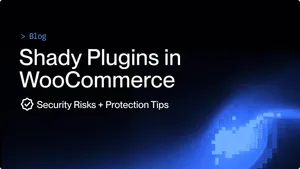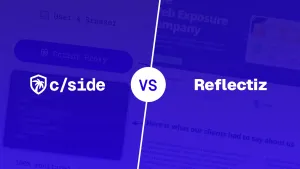WooCommerce is a powerful and flexible tool that helps you run an online store. One of the ways it does this is by letting plugins customize parts of your site like the checkout page using something called WordPress “filters”.
That flexibility is great but it also comes with a risk:If you install a bad plugin it can quietly change your checkout page in dangerous ways and WooCommerce can’t stop it.
We’re talking about malware injection, stolen credit card data and compliance violations. Not to mention the damage to your brand and customer trust…
The Checkout Attack Entrypoint in WooCommerce
While reviewing WooCommerce payment gateways (Credit Card and eCheck), we saw that plugins can inject their own HTML directly into the checkout form.
Code Snippet: How WooCommerce Passes Plugin HTML Into the Checkout
$fields = wp_parse_args(
$fields,
apply_filters('woocommerce_credit_card_form_fields', $default_fields, $this->id)
);
foreach ($fields as $field) {
echo $field; // This just prints whatever HTML the plugin gives it
}
WooCommerce expects plugins to behave well here. But the issue is it does NOT check or clean what the plugin sends. A plugin can add anything including dangerous scripts.
How WooCommerce Plugins Can Compromise Your Checkout Pages
Let’s say a WooCommerce site owner installs a shady plugin, maybe from a sketchy website or an unknown developer.
That plugin could inject a line of code like:
$fields['malicious_field'] = '<script>/* bad JavaScript here */</script>';This would then appear on your checkout page and every visitor would load that script. Since WooCommerce does not clean this output, this malicious script runs in the browser of your user. That’s a big deal.
Shady WooCommerce Plugins Steal Data From Your Customers
If a bad plugin were to inject a malicious line of code, here’s what could happen:
- Stealing payment info like credit card or eCheck details.
- Taking over customer sessions by stealing cookies.
- Redirecting users to fake (phishing) pages that look like your site.
- Damaging your brand users lose trust if your site gets compromised.
This is a supply chain problem where a single bad plugin can harm your entire store.
This Isn’t a WooCommerce Bug, It’s a General Browser-side Issue
To be clear, WooCommerce isn’t doing anything wrong here. This is how filters are supposed to work in WordPress.
But once a plugin is installed, WooCommerce has no way to tell if that plugin is good or bad. Plugins can touch sensitive parts of your site like the checkout form and that opens the door to trouble.
Every plugin adds risk. The more plugins you install, the more things can go wrong.
Even if WooCommerce as a platform is secure, a bad plugin can still cause major damage to your site.
How to Detect and Protect Against Malicious WooCommerce Plugins
1. Assess the Vendor Source
Better safe than sorry: ask yourself two quick questions.
- Can I trust the source?
- Where did I get this plugin?
If you’re not sure: stay away from random zip downloads. They’re not worth the headache. Stick with the safe bet and only download plugins from trusted sources, like those from the WordPress directory or trusted vendors. Make sure to check:
- The reviews (average rating, and recency of reviews)
- If the publisher an individual or a company
2. Is the Plugin Actively Maintained?
Don’t install blindly even from trusted vendors. Popular plugins can be abandoned. Take a quick look, when was the last update? Infrequent updates or plugins that are no longer being updated at all means they have not received adequate security patches.
3. Review Your List of Plugins (Update + Remove Unused Plugins)
Every WordPress admin falls into this trap. You install plugins and completely forget about them. Make it a habit to review and clean up your list of plugins. Make life a little easier for yourself, and keep the list short and clear. If you don’t need it, remove it.
Make sure to update plugins regularly. These updates often contain security patches that would otherwise leave your site exposed. And when you “uninstall” a plugin, make sure that you go through a full uninstall process. Some plugins will leave code on your backend even after they are uninstalled.
4. Search for Known Vulnerabilities
A quick Google search can save you a whole lot of pain. Just run a search on Google or an LLM like this: [plugin name] security vulnerabilities.

This screenshot shows the results for a known vulnerability for a review app that exposed 80,000 websites. If you identify a security vulnerability, select a different plugin or wait until the development team has patched the existing issue for the plugin you are assessing.
5. Use A Monitoring Tool
To automate this, you can lock down your plugins with a monitoring tool. If shady code sneaks in, you’ll know right away, before it harms your store or your customers’ trust.
There are multiple security plugins in the WordPress ecosystem that offer this functionality (make sure to assess their security as well).
You can also use a solution like cside that stops script injections as well as defending your users from a plethora of client-side attacks including:
- E-skimming, PII data exposure, malicious redirects, and stolen cookie session attacks
Keep WooCommerce Up to Date
Recent updates to WooCommerce have increasingly addressed script injections and cross site scripting attacks. Many successful attacks that impact merchants are due to an out-of-date instance of WooCommerce being used. Ensure that your site is up to date with the latest version (check your WordPress plugin list to see if there are updates available).
What WooCommerce Can Do
There’s you and then there’s WooCommerce. Each has to take measures for safety. Store owners are responsible for the plugins they pick and use. That’s the price they pay for the flexibility and ease of use of the WooCommerce solution with WordPress filters. That being said, a few extra guardrails by WooCommerce might help.
Why not clean up plugin code and strip out dangerous scripts before customers use them? WordPress already has tools like wp_kses() that strip out dangerous scripts, and WooCommerce could use them here.
Instead of dumping raw HTML, WooCommerce could use structured fields. For example, the plugin defines what it needs and WooCommerce renders the HTML. That way, WooCommerce stays in control.
It could also send out a warning to store owners or admins if a plugin is trying to modify the checkout form. This would add extra protection where it really matters.
While store owners are responsible for what they install, WooCommerce could add some protections, like:
- Escaping or sanitizing plugin-generated HTML using functions like wp_kses().
- Switching from raw HTML to structured fields, so that WooCommerce controls the final output.
- Warning admins when plugins modify sensitive parts of the checkout page.
Final Thoughts
This isn’t some scary new vulnerability or a flaw in WooCommerce, it’s just how the plugin system works. But it’s also a reminder:
Your store is only as secure as the plugins you install.
If you are using WooCommerce (or any platform like it), treat every plugin like it has access to your customers' wallets because it often does.












